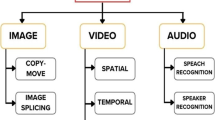Abstract
In this work we summarize biometric evidence as well as file type evidence extraction “exported” as formal Forensic Lucid language expression in the form of higher-order intensional contexts for further case analysis by a system that interprets Forensic Lucid expressions for claim verification and event reconstruction. The digital evidence is exported from the Modular Audio Recognition Framework (MARF)’s applications runs on a set of data comprising biometric voice recordings for speaker, gender, spoken accent, etc. as well as more general file type analysis using signal and pattern recognition processing techniques. The focus is in translation aspect of the extracted evidence into formal Forensic Lucid expressions for further analysis.
Access this chapter
Tax calculation will be finalised at checkout
Purchases are for personal use only
Preview
Unable to display preview. Download preview PDF.
Similar content being viewed by others
References
The MARF Research and Development Group, “The Modular Audio Recognition Framework and its Applications,” SourceForge.net, 2002– 2008, http://marf.sf.net, last viewed December 2008.
S. A. Mokhov, “Study of best algorithm combinations for speech processing tasks in machine learning using median vs. mean clusters in MARF,” in Proceedings of C3S2E’08, B. C. Desai, Ed. Montreal, Quebec, Canada: ACM and BytePress, May 2008, pp. 29–43, ISBN 978–1-60558–101–9.
S. A. Mokhov, “Writer Identification Using Inexpensive Signal ProcessingTechniques: Experimental Results,” 2008, unpublished.
S. A. Mokhov and M. Debbabi, “File type analysis using signal processing techniques and machine learning vs. file unix utility for forensic analysis,” in Proceedings of the IT Incident Management and IT Forensics (IMF’08), O. Goebel, S. Frings, D. Guenther, J. Nedon, and D. Schadt, Eds., Mannheim, Germany, Sep. 2008, pp. 73–85, LNI140.
S. A. Mokhov, “Towards syntax and semantics of hierarchical contexts in multimedia processing applications using MARFL,” in Proceedings of the 32nd Annual IEEE International Computer Software and Applications Conference (COMPSAC). Turku, Finland: IEEE Computer Society, Jul. 2008, pp. 1288–1294.
S. A. Mokhov and J. Paquet, “Formally specifying and proving operational aspects of Forensic Lucid in Isabelle,” Department of Electrical and Computer Engineering, Concordia University, Tech. Rep. 2008–1Ait Mohamed, Aug. 2008, in Theorem Proving in Higher Order Logics (TPHOLs2008): EmergingTrends Proceedings.
S. A. Mokhov, J. Paquet, and M. Debbabi, “Formally specifying operational semantics and language constructs of Forensic Lucid,” in Proceedings of the IT Incident Management and ITForensics (IMF’08), O. Goebel, S. Frings, D. Guenther, J. Nedon, and D. Schadt, Eds., Mannheim, Germany, Sep. 2008, pp. 197–216, LNI140.
E.A. Ashcroft and W.W.Wadge, “Lucid -a formal system for writing and proving programs,” SIAMJ. Comput., vol. 5, no. 3, 1976.
E.A. Ashcroft and W.W.Wadge, “Erratum: Lucid -a formal system for writing and proving programs.” SIAMJ. Comput., vol. 6, no. (1):200, 1977.
E.A. Ashcroft and W.W.Wadge, “Lucid, a nonprocedural language with iteration,” Communication of the ACM, vol. 20, no. 7, pp. 519–526, Jul. 1977.
W.Wadge and E. Ashcroft, Lucid, the Dataflow Programming Language. London: Academic Press, 1985.
E. Ashcroft, A. Faustini, R. Jagannathan, and W. Wadge, Multidimensional, Declarative Programming. London: Oxford University Press, 1995.
J. Paquet, “Scientific intensional programming,” Ph.D. dissertation, Department of Computer Science, Laval University, Sainte-Foy, Canada, 1999.
R. Lalement, Computation as Logic. Prentice Hall, 1993, C.A.R. Hoare Series Editor. English translation from French by John Plaice.
P. Rondogiannis, “Higher-order functional languages and intensional logic,” Ph.D. dissertation, Department of Computer Science, University ofVictoria,Victoria, Canada, 1994.
P. Gladyshev, “Finite state machine analysis of a blackmail investigation,” in International Journal of Digital Evidence. Technical and Security Risk Services, Sprint 2005,Volume 4, Issue 1, 2005.
P. Gladyshev and A. Patel, “Finite state machine approach to digital event reconstruction,” in Digital InvestigationJournal, vol. 2, 2004.
J. Paquet and P. Kropf, “The GIPSY architecture,” in Proceedings of Distributed Computing on theWeb, Quebec City, Canada, 2000.
J.Paquet, “Amulti-tier architecture for the distributed eductiveexecution of hybrid intensional programs,” 2008, submitted for publication at SAC’09.
P. Swoboda, “A formalisation and implementation of distributed intensional programming,” Ph.D. dissertation, The University of New South Wales, Sydney, Australia, 2004.
P. Swoboda and W. W. Wadge, “Vmake, ISE, and IRCS: General tools for the intensionalization of software systems,” in Intensional Programming II, M. Gergatsoulis and P. Rondogiannis, Eds. World-scientific, 2000.
P. Swoboda and J. Plaice, “A new approach to distributed context-aware computing,” in Advances in Pervasive Computing, A. Ferscha, H. Hoertner, and G. Kotsis, Eds. Austrian Computer Society, 2004, ISBN 3–85403-176–9.
P. Swoboda and J. Plaice, “An active functional intensional database,” in Advances in Pervasive Computing, F. Galindo, Ed. Springer, 2004, pp. 56–65, LNCS 3180.
L. C. Paulson and T. Nipkow, “Isabelle: A generic proof assistant,” University of Cambridge and Technical University of Munich, 2007, http://isabelle.in.tum.de/, last viewed: December 2007.
M. Debbabi, A. R. Arasteh, A. Sakha, M. Saleh, and A. Fry, “A collection of JPF forensic plug-ins,” Computer Security Laboratory, Concordia Institute for Information Systems Engineering, 2007–2008.
A. R. Arasteh and M. Debbabi, “Forensic memory analysis: From stack and code to execution history,” Digital Investigation Journal, vol. 4, no. 1, pp. 114–125, Sep. 2007.
A. R. Arasteh, M. Debbabi, A. Sakha, and M. Saleh, “Analyzing multiple logs for forensic evidence,” Digital InvestigationJournal, vol. 4, no. 1, pp. 82–91, Sep. 2007.
Acknowledgment
The author thanks Drs. Joey Paquet and Mourad Debbabi for the helpful and detailed review, suggestions, support, and comments about this work. We acknowledge reviewers who took time to review this work and provide us with constructive feedback. This work is sponsored in part by the Faculty of Engineering and Computer Science, Concordia University, Montreal, Canada.
Author information
Authors and Affiliations
Corresponding author
Editor information
Editors and Affiliations
Rights and permissions
Copyright information
© 2010 Springer Science+Business Media B.V.
About this paper
Cite this paper
Mokhov, S.A. (2010). Encoding Forensic Multimedia Evidence from MARF Applications as Forensic Lucid Expressions. In: Sobh, T., Elleithy, K., Mahmood, A. (eds) Novel Algorithms and Techniques in Telecommunications and Networking. Springer, Dordrecht. https://doi.org/10.1007/978-90-481-3662-9_71
Download citation
DOI: https://doi.org/10.1007/978-90-481-3662-9_71
Published:
Publisher Name: Springer, Dordrecht
Print ISBN: 978-90-481-3661-2
Online ISBN: 978-90-481-3662-9
eBook Packages: EngineeringEngineering (R0)



